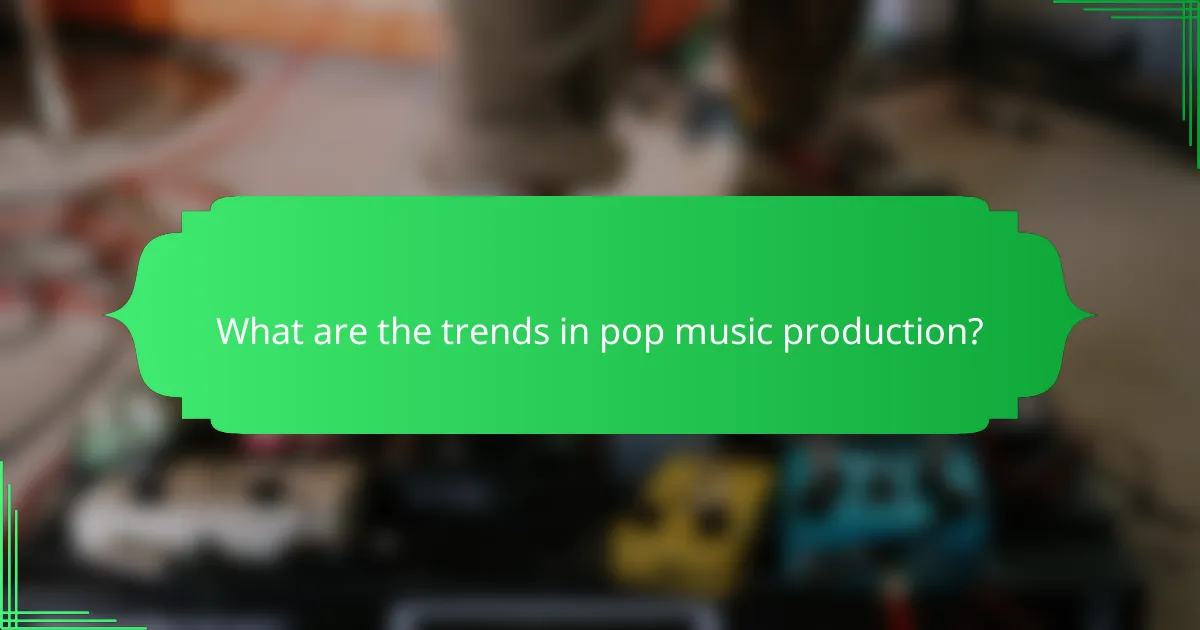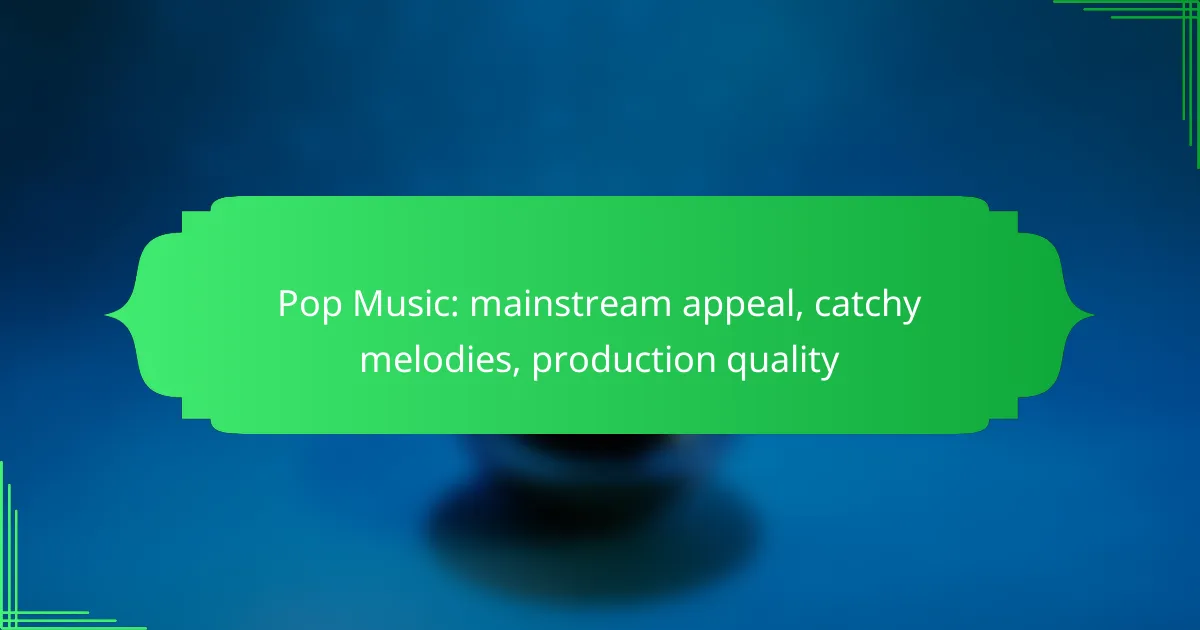Pop music captivates listeners with its infectious melodies, relatable lyrics, and exceptional production quality. Its straightforward structures and memorable choruses ensure broad appeal, allowing it to resonate across diverse audiences. High production standards further enhance the listening experience, making pop songs not only catchy but also impactful in popular culture.

How does pop music appeal to Canadian audiences?
Pop music appeals to Canadian audiences through its catchy melodies, relatable themes, and high production quality. The genre’s ability to resonate with diverse demographics makes it a staple in Canadian culture.
Mainstream artists like Drake and Justin Bieber
Mainstream artists such as Drake and Justin Bieber have significantly shaped the pop music landscape in Canada. Their global success not only elevates their personal brands but also highlights Canadian talent on the world stage.
Drake’s blend of hip-hop and pop, along with Bieber’s catchy pop anthems, create a strong connection with listeners. Their music often reflects personal experiences, making it relatable and appealing to a wide audience.
Catchy hooks and relatable lyrics
Catchy hooks and relatable lyrics are essential elements of pop music that draw in Canadian listeners. Songs often feature memorable choruses that encourage sing-alongs, enhancing the overall enjoyment of the music.
Relatable themes, such as love, heartbreak, and personal growth, resonate with listeners from various backgrounds. This emotional connection helps maintain a loyal fan base and encourages repeated listening.
Influence of social media platforms
Social media platforms play a crucial role in the popularity of pop music among Canadian audiences. Platforms like TikTok and Instagram allow users to share snippets of songs, creating viral trends that can propel tracks to mainstream success.
Artists leverage these platforms to engage with fans directly, promoting new releases and connecting through behind-the-scenes content. This interaction fosters a community around the music, making it more accessible and appealing to a younger demographic.

What are the key elements of catchy pop melodies?
Catchy pop melodies are characterized by their simplicity and memorability, making them appealing to a wide audience. Key elements include straightforward chord progressions, memorable choruses, and the effective use of repetition.
Simple chord progressions
Simple chord progressions form the backbone of catchy pop melodies. Common sequences, such as the I-IV-V or I-V-vi-IV, create a familiar sound that listeners can easily grasp. These progressions often consist of just three to four chords, allowing the melody to shine without overwhelming the listener.
For example, many popular songs utilize the I-V-vi-IV progression, which has been a staple in countless hits. This simplicity helps to establish a strong emotional connection, making the song more relatable and enjoyable.
Memorable choruses
A memorable chorus is crucial for a catchy pop melody, as it serves as the song’s focal point. This section is typically more dynamic and features a hook that resonates with listeners. A well-crafted chorus often includes a strong melody that is easy to sing along to, enhancing its appeal.
To create a memorable chorus, songwriters should focus on concise lyrics and a catchy melody that encapsulates the song’s theme. Repeating the chorus multiple times throughout the song reinforces its memorability and encourages audience participation.
Use of repetition
Repetition is a powerful tool in crafting catchy pop melodies, as it helps to embed the song in listeners’ minds. By repeating key phrases, melodies, or hooks, songwriters can create a sense of familiarity that draws listeners back to the song. This technique is often used in both verses and choruses.
However, it’s essential to strike a balance with repetition. Overusing it can lead to monotony, while strategic repetition can enhance a song’s catchiness. Aim for a few repeated lines or phrases that highlight the song’s core message, ensuring they remain fresh and engaging throughout the track.

How does production quality impact pop music?
Production quality significantly influences the appeal and success of pop music by enhancing sound clarity, richness, and overall listener experience. High production standards can elevate a song’s catchiness and memorability, making it more likely to resonate with a wide audience.
High production standards in studios
High production standards in studios are essential for creating polished pop music. Professional studios are equipped with high-end microphones, mixing consoles, and acoustic treatments that help capture and refine sound effectively. This environment allows artists to produce tracks that meet industry benchmarks, which is crucial for commercial success.
Moreover, adhering to high production standards ensures that the final mix translates well across various playback systems, from high-fidelity speakers to mobile devices. This versatility is key in today’s music consumption landscape, where listeners use diverse platforms.
Use of advanced technology and software
The use of advanced technology and software plays a pivotal role in modern pop music production. Digital Audio Workstations (DAWs) like Ableton Live and Logic Pro enable producers to manipulate sound with precision, allowing for intricate layering and effects that enhance the music’s appeal. These tools facilitate creativity and experimentation, leading to unique sounds that can capture listener interest.
Additionally, software plugins for mixing and mastering can elevate production quality by adding depth and clarity to tracks. For example, using equalizers and compressors can help balance frequencies and dynamics, making the music more engaging and radio-friendly.
Collaboration with top producers
Collaboration with top producers is a common strategy in pop music to achieve high production quality. Renowned producers bring expertise, industry connections, and a fresh perspective that can transform a song. Their experience often results in innovative arrangements and sound choices that enhance the track’s marketability.
Working with established producers can also provide access to better resources, including high-quality studio time and skilled session musicians. This collaboration can significantly elevate the overall production value, making the final product more appealing to both listeners and record labels.

What are the trends in pop music production?
Current trends in pop music production emphasize the integration of advanced technology, resulting in catchy melodies and high production quality. Producers are increasingly adopting innovative techniques to enhance sound and engage listeners effectively.
Incorporation of electronic elements
The incorporation of electronic elements is a defining characteristic of modern pop music. Synthesizers, drum machines, and digital audio workstations allow for a wide range of sounds and textures that can create infectious hooks and beats.
Producers often blend organic instruments with electronic sounds to create a unique sonic palette. For example, a pop track may feature a live guitar riff layered with synthesized bass lines, enhancing the overall appeal.
Focus on vocal processing techniques
Vocal processing techniques have become crucial in pop music production, enhancing the clarity and emotional impact of vocals. Techniques such as pitch correction, harmonization, and vocal layering are commonly used to create polished and engaging vocal tracks.
Producers may employ software like Auto-Tune or Melodyne to achieve precise vocal tuning, which can significantly elevate the song’s appeal. Additionally, adding effects like reverb and delay can create depth and atmosphere in the vocal presentation.
Emphasis on immersive soundscapes
Creating immersive soundscapes is a growing trend in pop music, aiming to envelop listeners in a rich auditory experience. This involves using spatial audio techniques and layered instrumentation to build a three-dimensional sound environment.
Producers often experiment with stereo imaging and surround sound formats to enhance the listening experience. For instance, incorporating ambient sounds or background vocals can add layers of complexity, making the track more engaging and memorable.

How do pop music genres evolve over time?
Pop music genres evolve through the blending of influences, cultural shifts, and technological advancements. As artists experiment with new sounds and styles, the genre adapts, leading to the emergence of new sub-genres and trends that reflect societal changes.
Fusion with hip-hop and R&B
The fusion of pop with hip-hop and R&B has significantly shaped modern pop music. This blend often results in catchy hooks and rhythmic beats that appeal to a broad audience. Notable examples include artists like Dua Lipa and The Weeknd, who incorporate elements from these genres into their pop hits, enhancing mainstream appeal.
Emergence of sub-genres like synth-pop
Sub-genres such as synth-pop have emerged as a response to technological advancements in music production. Synth-pop, characterized by its use of synthesizers and electronic sounds, gained popularity in the 1980s and has seen a resurgence in recent years. Artists like CHVRCHES and MUNA showcase how these retro influences can create fresh, engaging pop music.
Influence of cultural shifts and movements
Cultural shifts and movements play a crucial role in the evolution of pop music genres. Social issues, fashion trends, and technological innovations influence the themes and sounds of pop songs. For instance, the rise of social media has allowed artists to connect with fans directly, leading to more diverse voices and styles in the pop landscape, reflecting contemporary societal values and concerns.

What are the future trends in pop music?
The future of pop music is likely to be shaped by increased diversity, the rise of independent artists, and the integration of virtual reality experiences. These trends will redefine how music is created, consumed, and experienced, making the genre more inclusive and innovative.
Increased focus on diversity and representation
Pop music is increasingly embracing diversity and representation, reflecting a broader range of cultures, identities, and experiences. Artists from various backgrounds are gaining visibility, which enriches the genre and resonates with a wider audience.
This shift encourages record labels and producers to prioritize inclusive practices, ensuring that different voices are heard. For example, collaborations between artists from different genres and backgrounds are becoming more common, leading to fresh sounds and perspectives.
Growth of independent artists and labels
The rise of independent artists and labels is transforming the pop music landscape, allowing for greater creative freedom and innovation. With advancements in technology and distribution, many artists can produce and share their music without relying on major labels.
This trend is supported by platforms like Bandcamp and SoundCloud, where artists can reach audiences directly. As a result, listeners are discovering unique sounds that may not fit traditional pop molds, expanding the genre’s boundaries.
Integration of virtual reality experiences
Virtual reality (VR) is set to play a significant role in the future of pop music by offering immersive experiences that enhance fan engagement. Artists are experimenting with VR concerts and interactive music videos, allowing fans to experience performances in new and exciting ways.
This technology not only provides a unique way to enjoy music but also creates opportunities for artists to connect with their audience on a deeper level. As VR becomes more accessible, expect to see more pop music events that incorporate these cutting-edge experiences, changing how fans interact with their favorite artists.
